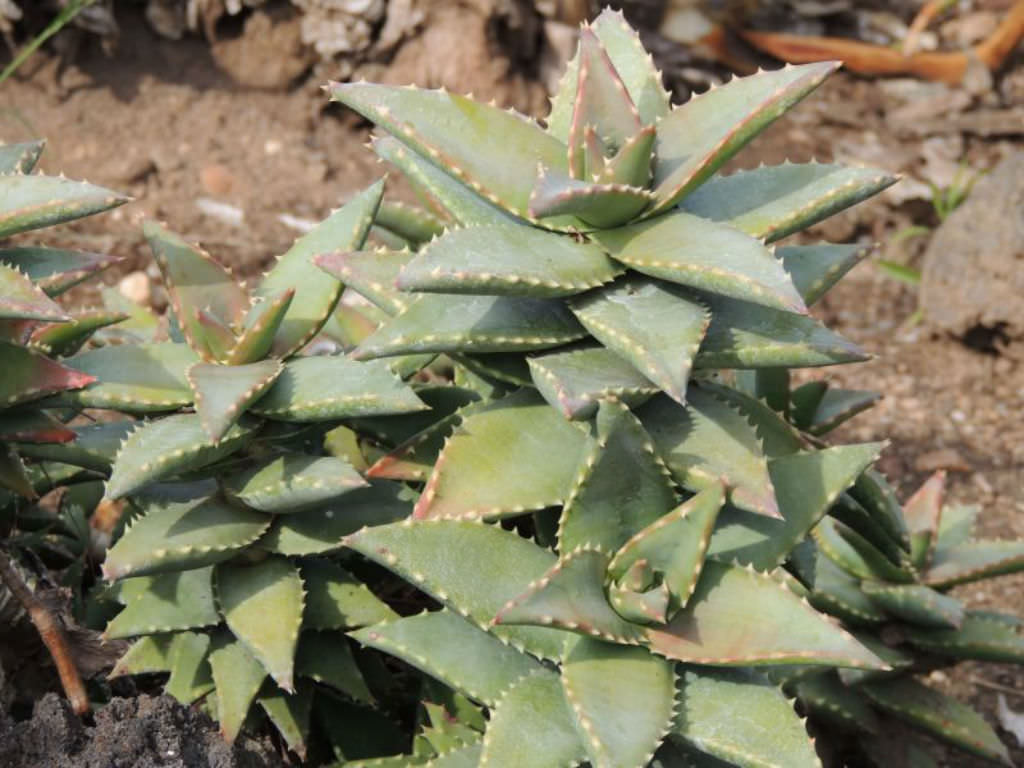This Aloe species, which has large, green leaves that turn red when exposed to intense summer sunlight, grows in clumps. In winter, when temperatures drop, the plant produces tall spikes with bell-shaped flowers in shades of red and orange. These blooms are only seen on mature specimens.
Table of Contents
Care and Propagation Information
Aloe ‘Hellskloof Bells’ is a slow-growing succulent that can reach impressive heights and has a long lifespan. However, it may take as long as 10 years for the plant to produce flowers.
Watering
Aloe ‘Hellskloof Bells’ will thrive if watered using the “soak and dry” technique, where the soil is allowed to become completely dry between watering sessions. This is the normal watering pattern for succulents.
Where to Plant
If the temperature drops below 20° F (-6.7° C) in your area, planting ‘Hellskloof Bells’ in a pot is the best option. Make sure to place it in a location that receives plenty of sunlight, either full or partial.
Put the plant in an area of the garden that gets at least six hours of sunlight daily; it may become leggy if grown indoors.
How to Propagate Aloe ‘Hellskloof Bells’
Aloe ‘Hellskloof Bells’ can be propagated both by taking cuttings and by using offsets, although the latter technique tends to be more successful.
Cuttings
To propagate ‘Hellskloof Bells’ from cuttings, employ a clean, sharp knife or scissors. Cut off the rosette from the top of the plant, and let it harden for a few days before planting it in a soil that drains well. Make sure to thoroughly water the soil only when it has completely dried out.
Offsets
The ‘Hellskloof Bells’ will generate small offshoots that sprout around the base of the plant. Take these out and let them dry for a period of one to two days before replanting them.
Care and Propagation Information
General Care for Aloe ‘Hellskloof Bells’
Watering
Aloe ‘Hellskloof Bells’ will thrive if watered using the “soak and dry” technique, where the soil is allowed to become completely dry between watering sessions. This is the normal watering pattern for succulents.
Where to Plant
If the temperature drops below 20° F (-6.7° C) in your area, planting ‘Hellskloof Bells’ in a pot is the best option. Make sure to place it in a location that receives plenty of sunlight, either full or partial.
Put the plant in an area of the garden that gets at least six hours of sunlight daily; it may become leggy if grown indoors.
How to Propagate Aloe ‘Hellskloof Bells’
Aloe ‘Hellskloof Bells’ can be propagated both by taking cuttings and by using offsets, although the latter technique tends to be more successful.
Cuttings
To propagate ‘Hellskloof Bells’ from cuttings, employ a clean, sharp knife or scissors. Cut off the rosette from the top of the plant, and let it harden for a few days before planting it in a soil that drains well. Make sure to thoroughly water the soil only when it has completely dried out.
Offsets
The ‘Hellskloof Bells’ will generate small offshoots that sprout around the base of the plant. Take these out and let them dry for a period of one to two days before replanting them.
FAQ
How does aloe vera store water?
The thick epidermis of aloe vera is essential for preserving moisture as it stops too much water from evaporating.
Can I grow aloe vera from a cutting?
Yes, you can propagate aloe vera from a stem cutting, as it is not possible to root the leaves on their own.
Why does aloe vera store water as a gel?
Aloes have evolved to survive in places that have little water. To do this, they have developed the ability to store large amounts of water in their tissues. Aloe vera, in particular, has thick, fleshy leaves which enable it to hold a lot of liquid.
Why does my aloe feel hollow?
If the root system is still healthy, you can rescue the plant by ensuring it is receiving the right amount of water. Make sure to not over water it, as this can cause the roots to die and prevent the water from reaching the leaves.



